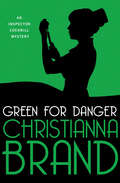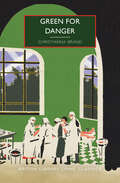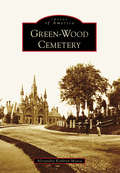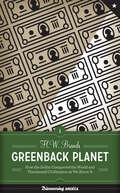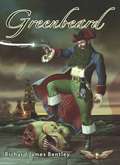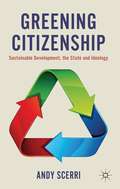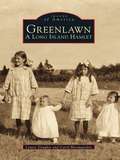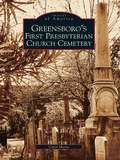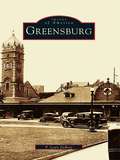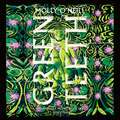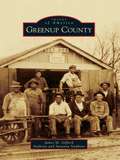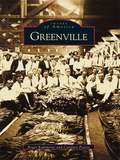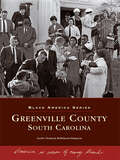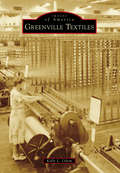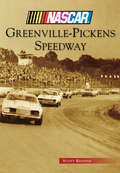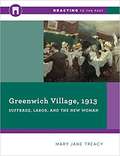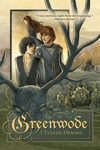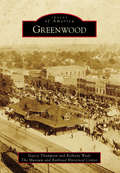- Table View
- List View
Green for Danger (The Inspector Cockrill Mysteries #2)
by Christianna BrandA man dies on the operating table, and Inspector Cockrill suspects murderAs German V-1 rockets rain down on the English countryside, the men and women of the military hospitals fight to stay calm. The morning after a raid, Doctor Barnes prepares for a routine surgery to repair a postman's broken leg. But with general anesthesia, there is always danger. Before the first incision is made, the postman turns purple. Barnes and his nurses do what they can, but the patient is dead in minutes. The coroner calls for an inquest. Barnes has a history of lost patients, and cannot afford more trouble. Scotland Yard Detective Inspector Cockrill is unimpressed by the staff at the hospital, which he finds a nest of jealousy, indiscretion, and bitterness. One of them, doctor or nurse, murdered the postman--and it won't be long before they kill again.
Green for Danger: The Official Anthology Of The Crime Writer's Association (British Library Crime Classics)
by Christianna Brand"Hands down one of the best formal detective stories ever written."— Kirkus Reviews, STARRED reviewThis Golden Age masterclass of red herrings and tricky twists, first published in 1944, features a tense and claustrophobic investigation with a close-knit cast of suspects."You have to reach for the greatest of the Great Names (Agatha Christie, John Dickson Carr, Ellery Queen) to find Christianna Brand's rivals in the subtleties of the trade."—Anthony Boucher in The New York TimesIt is 1942, and struggling up the hill to the new Kent military hospital Heron's Park, postman Joseph Higgins is soon to deliver seven letters of acceptance for roles at the infirmary. He has no idea that the sender of one of the letters will be the cause of his demise in just one year's time.When Higgins returns to Heron's Park with injuries from a bombing raid in 1943, his inexplicable death by asphyxiation in the operating theatre casts four nurses and three doctors under suspicion, and a second death in quick succession invites the presence of the irascible—yet uncommonly shrewd—Inspector Cockrill to the hospital. As an air raid detains the inspector for the night, the stage is set for a tense and claustrophobic investigation with a close-knit cast of suspects.
Green with Milk and Sugar: When Japan Filled America’s Tea Cups
by Robert HellyerToday, Americans are some of the world’s biggest consumers of black teas; in Japan, green tea, especially sencha, is preferred. These national partialities, Robert Hellyer reveals, are deeply entwined. Tracing the transpacific tea trade from the eighteenth century onward, Green with Milk and Sugar shows how interconnections between Japan and the United States have influenced the daily habits of people in both countries.Hellyer explores the forgotten American penchant for Japanese green tea and how it shaped Japanese tastes. In the nineteenth century, Americans favored green teas, which were imported from China until Japan developed an export industry centered on the United States. The influx of Japanese imports democratized green tea: Americans of all classes, particularly Midwesterners, made it their daily beverage—which they drank hot, often with milk and sugar. In the 1920s, socioeconomic trends and racial prejudices pushed Americans toward black teas from Ceylon and India. Facing a glut, Japanese merchants aggressively marketed sencha on their home and imperial markets, transforming it into an icon of Japanese culture.Featuring lively stories of the people involved in the tea trade—including samurai turned tea farmers and Hellyer’s own ancestors—Green with Milk and Sugar offers not only a social and commodity history of tea in the United States and Japan but also new insights into how national customs have profound if often hidden international dimensions.
Green-Wood Cemetery (Images of America)
by Alexandra Kathryn MoscaFor generations, Green-Wood Cemetery has played an integral part in New York City's cultural history, serving as a gathering place and a cultural repository. Situated in the historic borough of Brooklyn, the thousands of graves and mausoleums within the cemetery's 478 acres are tangible links and reminders to key events and people who made New York City and America what it is today. The monuments read like a who's who of American greatness and include the names of Leonard Bernstein, F. A. O. Schwarz, Charles L. Tiffany, Samuel Morse, and DeWitt Clinton, among others. A national historic landmark since 2006, Green-Wood is considered one of the preeminent cemeteries in the country and is a living display of the evolving funeral traditions of the city and America as a whole. The cemetery was and remains one of the city's largest open green spaces and a century ago was a social venue for picnics, outings, and political events. Through vintage photographs, Green-Wood Cemetery chronicles the cemetery's rich history and documents how its tradition as a park and a popular tourist attraction continues, drawing 300,000 visitors annually.
Green: The History of a Color
by Michel PastoureauIn this beautiful and richly illustrated book, the acclaimed author of Blue and Black presents a fascinating and revealing history of the color green in European societies from prehistoric times to today. Examining the evolving place of green in art, clothes, literature, religion, science, and everyday life, Michel Pastoureau traces how culture has profoundly changed the perception and meaning of the color over millennia—and how we misread cultural, social, and art history when we assume that colors have always signified what they do today.Filled with entertaining and enlightening anecdotes, Green shows that the color has been ambivalent: a symbol of life, luck, and hope, but also disorder, greed, poison, and the devil. Chemically unstable, green pigments were long difficult to produce and even harder to fix. Not surprisingly, the color has been associated with all that is changeable and fleeting: childhood, love, and money. Only in the Romantic period did green definitively become the color of nature.Pastoureau also explains why the color was connected with the Roman emperor Nero, how it became the color of Islam, why Goethe believed it was the color of the middle class, why some nineteenth-century scholars speculated that the ancient Greeks couldn't see green, and how the color was denigrated by Kandinsky and the Bauhaus.More broadly, Green demonstrates that the history of the color is, to a large degree, one of dramatic reversal: long absent, ignored, or rejected, green today has become a ubiquitous and soothing presence as the symbol of environmental causes and the mission to save the planet.With its striking design and compelling text, Green will delight anyone who is interested in history, culture, art, fashion, or media.
Greenback Planet: How the Dollar Conquered the World and Threatened Civilization as We Know It (Discovering America)
by H. W. BrandsFrom the New York Times–bestselling historian and two-time Pulitzer Prize finalist, &“[a] compact summation of our nation&’s monetary history&” (Shepherd Express). The world runs on the US dollar. From Washington to Beijing, governments, businesses, and individuals rely on the dollar to conduct commerce and invest profitably and safely. But how did the greenback achieve this planetary dominance a mere century and a half after President Lincoln issued the first currency backed only by the credit—and credibility—of the federal government? In Greenback Planet, acclaimed historian H. W. Brands charts the dollar&’s astonishing rise to become the world&’s principal currency. Telling the story with the verve of a novelist, he recounts key episodes in U.S. monetary history, from the Civil War debate over fiat money (greenbacks) to the recent worldwide financial crisis. Brands explores the dollar&’s changing relations to gold and silver and to other currencies and cogently explains how America&’s economic might made the dollar the fundamental standard of value in world finance. He vividly describes the 1869 Black Friday attempt to corner the gold market, banker J. P. Morgan&’s bailout of the U.S. treasury, the creation of the Federal Reserve, and President Franklin Roosevelt&’s handling of the bank panic of 1933. Brands shows how lessons learned (and not learned) in the Great Depression have influenced subsequent U.S. monetary policy, and how the dollar&’s dominance helped transform economies in countries ranging from Germany and Japan after World War II to Russia and China today. He concludes with a sobering dissection of the 2008 world financial debacle, which exposed the power—and the enormous risks—of the dollar&’s worldwide reign.
Greenback Planet: How the Dollar Conquered the World and Threatened Civilization as We Know It (Discovering America)
by H. W. BrandsFrom the New York Times–bestselling historian and two-time Pulitzer Prize finalist, &“[a] compact summation of our nation&’s monetary history&” (Shepherd Express). The world runs on the US dollar. From Washington to Beijing, governments, businesses, and individuals rely on the dollar to conduct commerce and invest profitably and safely. But how did the greenback achieve this planetary dominance a mere century and a half after President Lincoln issued the first currency backed only by the credit—and credibility—of the federal government? In Greenback Planet, acclaimed historian H. W. Brands charts the dollar&’s astonishing rise to become the world&’s principal currency. Telling the story with the verve of a novelist, he recounts key episodes in U.S. monetary history, from the Civil War debate over fiat money (greenbacks) to the recent worldwide financial crisis. Brands explores the dollar&’s changing relations to gold and silver and to other currencies and cogently explains how America&’s economic might made the dollar the fundamental standard of value in world finance. He vividly describes the 1869 Black Friday attempt to corner the gold market, banker J. P. Morgan&’s bailout of the U.S. treasury, the creation of the Federal Reserve, and President Franklin Roosevelt&’s handling of the bank panic of 1933. Brands shows how lessons learned (and not learned) in the Great Depression have influenced subsequent U.S. monetary policy, and how the dollar&’s dominance helped transform economies in countries ranging from Germany and Japan after World War II to Russia and China today. He concludes with a sobering dissection of the 2008 world financial debacle, which exposed the power—and the enormous risks—of the dollar&’s worldwide reign.
Greenback: The Almighty Dollar and the Invention of America
by Jason GoodwinEconomic history of money in the US.
Greenbeard
by Richard James BentleyCaptain Sylvestre de Greybagges is your typical seventeenth-century Cambridge-educated lawyer turned Caribbean pirate, as comfortable debating the virtues of William Shakespeare, Isaac Newton, and compound interest as he is wielding a cutlass, needling archrival Henry Morgan, and parsing rum-soaked gossip for his next target. When a pepper monger's loose tongue lets out a rumor about a fleet loaded with silver, the Captain sets sail only to find himself in a close encounter of a very different kind.After escaping with his sanity barely intact and his beard transformed an alarming bright green, Greybagges rallies The Ark de Triomphe crew for a revenge-fueled adventure to the ends of the earth and beyond.Destined to become a cult favorite, this frolicsome tale of skullduggery, jiggery-pokery, and chicanery upon Ye High Seas is brimming with hilarious puns, masterful historical allusions, and nonstop literary hijinks. Including sly references to Thomas Pynchon, Treasure Island, 1940s cinema, and notable historical figures, this mélange of delights will captivate readers with its rollicking adventure, rich descriptions of food and fashion, and learned asides into scientific, philosophical, and colonial history.Richard James Bentley, who happens to look the part of a salty English sea captain, has trodden many paths and worn many hats. From his early work as a dealer in dodgy motorcars, he progressed to being a design engineer on a zeppelin project. Computers then caught his attention and he authored a number of incomprehensible technical manuals before turning to fiction. He has lived in Switzerland and the Netherlands and now spins yarns in the north of England. Greenbeard is his first novel.
Greening Citizenship
by Andy ScerriThe greening of citizenship, the state and ideology has created both opportunities and bottlenecks for progressive political movements. Scerri argues that these are pursuing justice by making holistic demands for: fair distribution and status recognition, adequate representation and effective participation.
Greening the Alliance: The Diplomacy of NATO's Science and Environmental Initiatives
by Simone TurchettiFollowing the launch of Sputnik, the North Atlantic Treaty Organization became a prominent sponsor of scientific research in its member countries, a role it retained until the end of the Cold War. As NATO marks sixty years since the establishment of its Science Committee, the main organizational force promoting its science programs, Greening the Alliance is the first book to chart NATO’s scientific patronage—and the motivations behind it—from the organization’s early days to the dawn of the twenty-first century. Drawing on previously unseen documents from NATO’s own archives, Simone Turchetti reveals how its investments were rooted in the alliance’s defense and surveillance needs, needs that led it to establish a program prioritizing environmental studies. A long-overlooked and effective diplomacy exercise, NATO’s “greening” at one point constituted the organization’s chief conduit for negotiating problematic relations between allies. But while Greening the Alliance explores this surprising coevolution of environmental monitoring and surveillance, tales of science advisers issuing instructions to bomb oil spills with napalm or Dr. Strangelove–like experts eager to divert the path of hurricanes with atomic weapons make it clear: the coexistence of these forces has not always been harmonious. Reflecting on this rich, complicated legacy in light of contemporary global challenges like climate change, Turchetti offers both an eye-opening history of international politics and environmental studies and a thoughtful assessment of NATO’s future.
Greenlawn: A Long Island Hamlet (Images of America)
by Carol Bloomgarden Louise DougherFrom the archives of the Greenlawn-Centerport Historical Association comes this striking visual history of the north shore Long Island hamlet of Greenlawn. Originally known as Oldfields, the area was settled in the early 1800s by farmers. The extension of the Long Island Railroad through the farmlands in 1867-1868 provided the impetus for the development of a profitable pickle and cabbage industry, the growth of the community, and the arrival of vacationers, many of whom soon became year-round residents. Greenlawn includes stories of the Halloween eve conflagration, the Adirondack-style vacation retreat, the opera house, the farmhouse murders, the vaudevillians, and the Pickle King, among others. Today, houses cover the old farmlands; yet Greenlawnwith -one main street of small shops, a railroad crossing that halts traffic throughout the day, and many historical buildings-still retains its small-town charm.
Greensboro
by Kevin ReidGreensboro has reinvented itself in recent decades. By the time of its 1958 sesquicentennial, Greensboro was North Carolina's second-largest city and the world's largest producer of denim. It was home to many textile companies, including the world's largest; major insurance firms; and manufacturers of other products. Greensboro holds an important place in the civil rights movement, with the sit-ins at Woolworth's department store, a site now preserved as the International Civil Rights Center & Museum. In 1982, a grocery store opened in Greensboro that wanted to bring the old-fashioned market experience back to consumers. The Fresh Market has since expanded to over 100 stores in more than 20 states. Greensboro's roster of colleges and universities has grown over the years, and it remains a key education and research center. Founded in 1991, RF Micro Devices, Greensboro's largest company, makes components of most cell phones. Greensboro showcases the rich commercial and community history of this city over the past 50 years.
Greensboro's First Presbyterian Church Cemetery (Images of America)
by Carol MooreHistoric First Presbyterian Church Cemetery was established in 1831 and over time has survived vandalism, storms, an earthquake, and threats of removal. It is a lasting remembrance to the early citizens of Greensboro who carved a city out of the wilderness. Originally the cemetery was located on the edge of town, but because of Greensboro's growth, it is now nestled in the center of the cultural district behind the Greensboro Historical Museum. Those buried in the cemetery are from all walks of life-from wealthy to poor, those with doctorate degrees to the illiterate, the famous to those whose names are lost for all time, the newborn to the centenarian, the saint to the sinner, and the slave owner to the abolitionist. The early builders of the city and state and veterans of four wars now rest in the First Presbyterian Church Cemetery.
Greensburg
by P. Louis DeroseBy 1771, a cluster of cabins flanked what would become the most traveled east-west road between the Allegheny Mountains and Pittsburgh. This settlement, originally called Newtown, emerged as the nucleus of a growing community later renamed for the late General Nathanael Greene. By 1799, Greensburg was already the first county seat and site of the first courts west of the mountains. With the coming of the Pennsylvania Railroad and bituminous coal mining, Greensburg by 1885 was growing, prospering, and bustling with commercial activity. Utilizing rare photographs, some unseen in sixty years, Greensburg concentrates on the city's evolution past 1900, into the years of boom and growth, and through the 1950s, hinting of future decline.
Greenteeth
by Molly O'Neill'A CHARMINGLY MONSTROUS DEBUT' T. Kingfisher, author of Nettle and Bone'FULL OF MAGIC BUT EVEN MORE HEART' Kirkus (starred review)Narrated by a lake-dwelling monster, Greenteeth is an utterly charming tale of fae, folklore and found family, perfect for fans of T. Kingfisher.Beneath the still surface of a lake lurks a monster with needle sharp teeth. Hungry and ready to pounce . . .Jenny Greenteeth has never spoken to a human before, but when a witch is thrown into her lake by an angry mob, something makes Jenny decide she's worth saving. Temperance doesn't know why her village has suddenly turned against her, only that it has something to do with the malevolent new pastor. All she wants is to return to her husband and children.Though they have nothing in common, these two unlikely companions must band together on a magical quest to defeat the evil that threatens Temperance's family, Jenny's lake, and possibly the very soul of Britain.'Charming, magical and intensely human . . . a masterclass in the art of storytelling' Tom Holt, author of The Portable Door'Greenteeth is a delight - a joyful, warm-hearted adventure, riddled with unique characters and poignant friendships, rooted deep in old magic and myth. Jenny's voice will live in your head long after you leave her story behind' H. G. Parry, author of The Magician's DaughterFive-star reader reviews:'What an absolutely magnificent book this was! I may have already found my best book of the year!''An absolute smash of a debut . . . It's fun, it's emotional, it's adorable and it's tense. What. A. Package!''A breathtaking, somewhat cosy, definitely monstrous, heartwarming and adventurous tale that has swept me off my feet''A wonderful cosy fantasy that had me smiling from ear to ear''WOW I was soooo taken aback by how much I absolutely enjoyed this book!!! Loved it so much!''A beautiful tale utterly steeped in folklore . . . I absolutely adored this . . . all the stars'
Greenteeth: A monstrously cosy tale of fae, folklore and found family
by Molly O'Neill'A CHARMINGLY MONSTROUS DEBUT' T. Kingfisher, author of Nettle and Bone'FULL OF MAGIC BUT EVEN MORE HEART' Kirkus (starred review)Narrated by a lake-dwelling monster, Greenteeth is an utterly charming tale of fae, folklore and found family, perfect for fans of T. Kingfisher.Beneath the still surface of a lake lurks a monster with needle sharp teeth. Hungry and ready to pounce . . .Jenny Greenteeth has never spoken to a human before, but when a witch is thrown into her lake by an angry mob, something makes Jenny decide she's worth saving. Temperance doesn't know why her village has suddenly turned against her, only that it has something to do with the malevolent new pastor. All she wants is to return to her husband and children.Though they have nothing in common, these two unlikely companions must band together on a magical quest to defeat the evil that threatens Temperance's family, Jenny's lake, and possibly the very soul of Britain.'Charming, magical and intensely human . . . a masterclass in the art of storytelling' Tom Holt, author of The Portable Door'Greenteeth is a delight - a joyful, warm-hearted adventure, riddled with unique characters and poignant friendships, rooted deep in old magic and myth. Jenny's voice will live in your head long after you leave her story behind' H. G. Parry, author of The Magician's DaughterFive-star reader reviews:'What an absolutely magnificent book this was! I may have already found my best book of the year!'⭐⭐⭐⭐⭐'An absolute smash of a debut . . . It's fun, it's emotional, it's adorable and it's tense. What. A. Package!'⭐⭐⭐⭐⭐'A breathtaking, somewhat cosy, definitely monstrous, heartwarming and adventurous tale that has swept me off my feet'⭐⭐⭐⭐⭐'A wonderful cosy fantasy that had me smiling from ear to ear'⭐⭐⭐⭐⭐'WOW I was soooo taken aback by how much I absolutely enjoyed this book!!! Loved it so much!'⭐⭐⭐⭐⭐'A beautiful tale utterly steeped in folklore . . . I absolutely adored this . . . all the stars'⭐⭐⭐⭐⭐
Greenup County
by James M. Gifford Anthony Stephens Suzanna StephensGreenup County, bordering the Ohio River in northeast Kentucky, is rich in history and culture. Settlers first arrived in the mid-1700s and carved farms from the hardwood forests. Lucy Virgin Downs, the first white child born west of the Alleghenies, lived in Greenup County, as did Jesse Boone, brother of Kentucky icon Daniel Boone. The 20th century brought industrialization and economic diversification to the historically agricultural area. Ashland Oil, a Fortune 500 company, maintained corporate headquarters in Greenup County. Two steel mills, a large rail yard, an excellent hospital, and a number of surface mines also provided employment to many people who continued to work their family farms, too. This economic progress was mirrored in every aspect of county life as education, health care, and recreation all improved dramatically. Today Greenup County's history is appreciated by both longtime residents and cultural tourists.
Greenville
by Candace Pearce Roger KammererLocated along the Tar River in the eastern half of North Carolina, Greenville exists today as a thriving center of commerce, education, medicine, the arts, and quality living. Since its earliest days in the 1770s, the city has expanded in size and population with the arrival of the railroad, the popularity of tobacco, and the rise in education. Age covers a city with a patina of experience that is apparent in many aspects of Greenville. Such beauty is evident in the preservation of photographs and stories that pay homage to the city of yesteryear. Greenville is a celebration of the community's coming of age. The images within these pages reach over the horizon of memory and evoke the proud chapters in the city's history. The pictures speak of simpler days, hard work, buggy rides, a stick of candy, and peoplewatching the trains come in. They recall the days when steamboats plied the Tar River and when the tobacco market was the most important time of year. Yet, this volume does not merely depict a vanished ghost; the subject lives on, surviving through renovated buildings, along streets that have simply evolved, and in the faces of the children and grandchildren who, as it turns out, are not so different from those captured in these scenes.
Greenville County, South Carolina (Black America Series)
by Leola Clement Robinson-SimpsonCradled at the foothills of the beautiful Blue Ridge Mountains and once known as the "Textile Center of the South," Greenville has evolved into a prosperous hub for corporate development and global commerce. Greenville County's African American community, proud and resourceful, has strong roots dating back to 1770, when blacks helped to carve the county out of an upstate wilderness. The experiences of the black community and its long relationship with whites up to the civil rights movement helped to create the climate for the kaleidoscope of races and cultures in Greenville today.
Greenville Textiles (Images of America)
by Kelly L. OdomGreenville's textile heritage is what made the community the economic force it is today. From its antebellum beginnings with only a handful of mills, Greenville continued to grow industrially as more and more Northern investors saw financial opportunity in the area. With its notable feats, such as having the largest textile mill under one roof to its many mills fighting off "flying squadrons" during the General Textile Strike of 1934, the county's textile past is as rich and colorful as the fabrics it produced. Greenville's ascension to the "Textile Capital of the World" was unfortunately followed by the flood of overseas goods, resulting in the closing of many Upstate institutions. Though these mills are now silent, their efforts are what attracted so many other industries to the area.
Greenville-Pickens Speedway
by Scott KeepferAs the second-oldest NASCAR track still running weekly races, Greenville-Pickens has earned a unique niche in racing history. In 1959, local driver David Pearson sped to a record 15 victories in one season, jump-starting a Hall of Fame career. As a young boy, Dale Earnhardt played in the infield while his father, Ralph, raced to the track championship in 1965. In 1971, ABC's Wide World of Sports televised the first live, start-to-finish NASCAR race at Greenville-Pickens. Many big names have competed here, but for every David Pearson and Richard Petty, there have been dozens of Donnie Bishops and Toby Porters: local favorites providing weekly thrills for a loyal fan base.
Greenwich Village 1913: Suffrage, Labor, And The New Woman
by Mary Jane TreacyIn this Reacting to the Past game, the classroom is transformed into Greenwich Village in 1913, where rebellious “free spirits” gather. Exposed to ideas like woman suffrage, socialism, birth control, and anarchism, students experiment with forms of political participation and bohemian self-discovery. Reacting to the Past is an award-winning series of immersive role-playing games that actively engage students in their own learning. Students assume the roles of historical characters and practice critical thinking, primary source analysis, and argument, both written and spoken.
Greenwode (The Wode #1)
by J Tullos Hennig2nd EditionBook One of The WodeThe Hooded One. The one to breathe the dark and light and dusk between.... When an old druid foresees this harbinger of chaos, he also glimpses its future. A peasant from Loxley will wear the Hood and, with his sister, command a last, desperate bastion of Old Religion against New. Yet a devout nobleman's son could well be their destruction--Gamelyn Boundys, whom Rob and Marion have befriended. Such acquaintance challenges both duty and destiny. The old druid warns that Rob and Gamelyn will be cast as sworn enemies, locked in timeless and symbolic struggle for the greenwode's Maiden. Instead, a defiant Rob dares his Horned God to reinterpret the ancient rites, allow Rob to take Gamelyn as lover instead of rival. But in the eyes of Gamelyn's Church, sodomy is unthinkable... and the old pagan magics are an evil that must be vanquished.First Edition published by Dreamspinner Press, January 2013
Greenwood
by The Museum and Railroad Historical Center Bethany Wade Stacey ThompsonNamed by an early settler's wife as she gazed at the lush surroundings of her summer home, Greenwood was incorporated on December 21, 1857. Growing from a fledgling village into a town that at one time boasted "the widest Main Street in the world," the city grew due to two industries: the railroad and textiles. Railroad companies such as Piedmont & Northern and Seaboard built their way through Greenwood, while textile tycoons such as James C. Self and John Pope Abney worked hard to increase productivity and job opportunities. Soon, education, businesses, and community services followed suit. Greenwood was booming, making the small town a place of educational advancement, great entrepreneurial spirit, and community-minded individuals.
